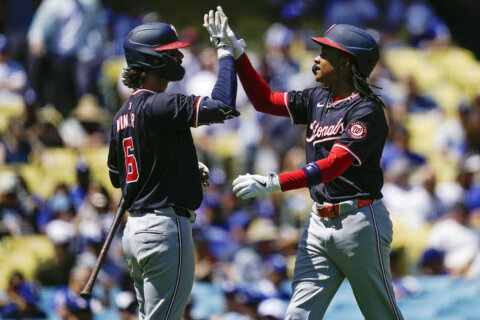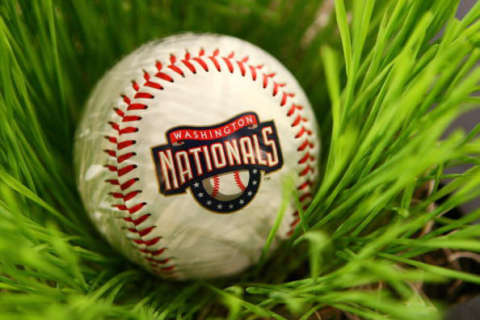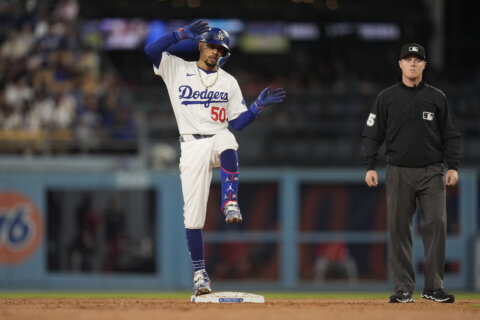Before he’d recorded his fifth out on Tuesday night against the White Sox, Stephen Strasburg had already given up five runs, and it looked like career victory No. 100 would have to wait for his next start.
With an offense that had been struggling and a bullpen that’s been a seasonlong nightmare, there seemed to be little hope of a win after five innings, when he exited down 5-3, having thrown 105 pitches.
Then things changed dramatically. The Nationals scored six runs in the bottom of the fifth; the bullpen miraculously threw four scoreless innings, and Strasburg earned that 100th victory.
While 100 wins is certainly an accomplishment to be proud of — every team would like to have a pitcher who wins that many in less than nine and a half seasons — it’s not exactly what we envisioned the night he made his major league debut. Anything in the universe seemed possible June 8, 2010.
When the Nationals made Strasburg the No. 1 pick of the draft a year earlier, his talent was considered generational. Playing for major league Hall of Famer Tony Gwynn at San Diego State, Strasburg’s reputation spread across the country. He was the only amateur selected for the 2008 Olympic team. He once struck out 23 against Utah. He reportedly reached 103 mph on the radar gun. And unlike most rocket arms his age, Strasburg was said to have pinpoint control. All you had to do was draft him and start counting the Cy Young awards.
Through stops in Harrisburg and Syracuse in 2009 and 2010, Strasburg made 11 starts, going 7-2 with a 1.30 ERA and 65 strikeouts. Future Hall of Fame catcher Iván “Pudge” Rodriguez was with the Nats in 2010 and caught a bullpen session with Strasburg in spring training. Since Rodriguez had come over from the Tigers, he was asked whether the young pitcher compared to Justin Verlander. Rodriguez said, “No — Nolan.” He meant Nolan Ryan, he of the seven no-hitters and more strikeouts than anybody in the history of the game. Rodriguez had been teammates with Ryan in Texas in 1993.
Rodriguez would have the honor of catching the young phenom in his debut, against Pittsburgh at Nationals Park. More than 200 media credentials were issued, and ESPN did all its shows all day from the ballpark. It was suggested that it may have been the most anticipated debut in major league history. Nats team president Stan Kasten, who had been working in professional sports for decades, didn’t disagree: “I think it’s fair to say we’ve never seen anything like this in baseball.”
Rarely in a situation like this does the event outrun the hype. This time, event sprinted past hype like Carl Lewis running the anchor leg in the 4×100 in the Olympics.
A fan base that didn’t have a team six years earlier filled all 40,315 seats and witnessed baseball history. Aside from giving up a two-run homer to Delwyn Young in the fourth inning, Strasburg was nearly perfect. He threw 94 pitches, 65 for strikes, and only eight balls were put in play. By the time he exited after seven innings, Strasburg had struck out 14 Pirates, including the last seven he faced. The 14 strikeouts were one short of the major league record for a debut shared by Brooklyn’s Karl Spooner (1954) and Houston’s J.R. Richard (1971).
After the Nats’ 5-2 win, Rodriguez said Pirate batters had expressed their amazement to him about the kid’s speed. And then the real gushing began.
The injury
Veteran reporters who’d seen everything wrote that they’d never seen anything like it. Peter Kerasotis, of Florida Today, wrote, “It felt like seeing da Vinci’s first brush stroke on the Mona Lisa, or hearing the opening note of Beethoven’s 5th Symphony, or smelling the first piece of falling marble from Michelangelo’s David.”
Others may have said it, but Albert Chen of Sports Illustrated seems to have gotten the credit for coining the term “Strasmas” — as in, for Nats fans, every fifth day would be Strasmas.
For a while it was. Over the next two months, I remember looking at the schedule, factoring in off days and rainouts and trying to figure out when the next Strasburg start would be. He was not quite as unhittable as he’d been June 8, but still awfully good. And then it ended for a while.
After being scratched from a previous start because of what was called forearm tightness while warming up, Strasburg pitched on Aug. 21. He left early with an elbow issue that was diagnosed a day later as a “torn ulnar collateral ligament.” Tommy John surgery. See ya in a year.
Strasburg made a few appearances at the end of the 2011 season and certainly looked ready to open up 2012. As a bonus, Strasburg would have Davey Johnson as his manager.
Johnson knew good young pitchers. He’d had a bunch of them with the Mets in the 1980s, including Dwight “Doc” Gooden, who had one of the best years in baseball history in 1985. Johnson said Strasburg reminded him of Gooden because of his combination of speed and control.
The shutdown
There was only one problem: his innings count. General Manager Mike Rizzo firmly believes in protecting pitchers coming off Tommy John surgery. Strasburg’s season would end after 180 innings, no matter what. Rizzo had no intention of seeing Strasburg reinjure the elbow from overwork.
When it was announced in spring training, it didn’t seem to matter much. It didn’t seem the Nats were going anywhere that season, so shutting Strasburg down in September wouldn’t be a big deal. They’d done the same thing to Jordan Zimmermann the year before.
Problem was, by midseason the Nats looked playoff-worthy, and possibly good enough to make the World Series. Innings, schminnings — Strasburg has to pitch in the postseason, right? Wrong, said Rizzo.
To this day, you can still strike up a good bar argument over whether Strasburg should have been shut down. Maybe he’d have been the difference between winning and losing that heartbreaking five-game first-round series to St. Louis. We’ll never know.
In the years since, you can’t argue that Strasburg hasn’t been good. Though he hasn’t been as durable as some would like and has never won more than 15 games in a season, he’s been an All-Star three times, came in third in the Cy Young voting in 2017 when he went 15-4 with a 2.52 ERA, and was the fastest to 1,500 strikeouts in history. When he signed a seven year, $175 million contract extension in 2016, it appeared the Nats were getting a bargain. If Max Scherzer hadn’t landed in Washington, Strasburg would be considered the greatest pitcher in franchise history.
Aside from Mike Trout, who somehow slid into the late part of the draft to the Angels, if you had to pick first again in 2009 you’d still pick Strasburg. But if you still have images of that magical June night nine years ago, it’s hard to get your head around what he’s been. Awfully good just doesn’t seem quite good enough in comparison. Then again, realistically, how could it?







